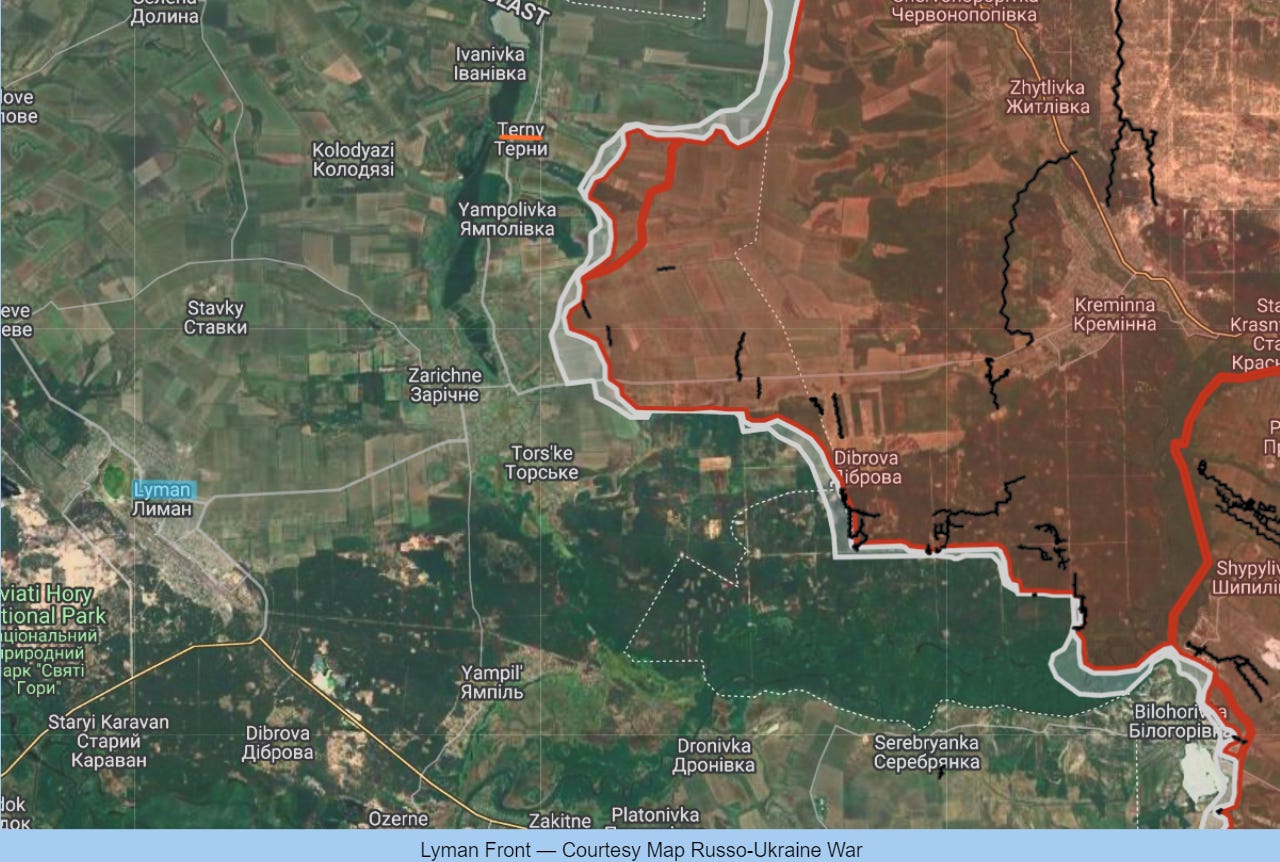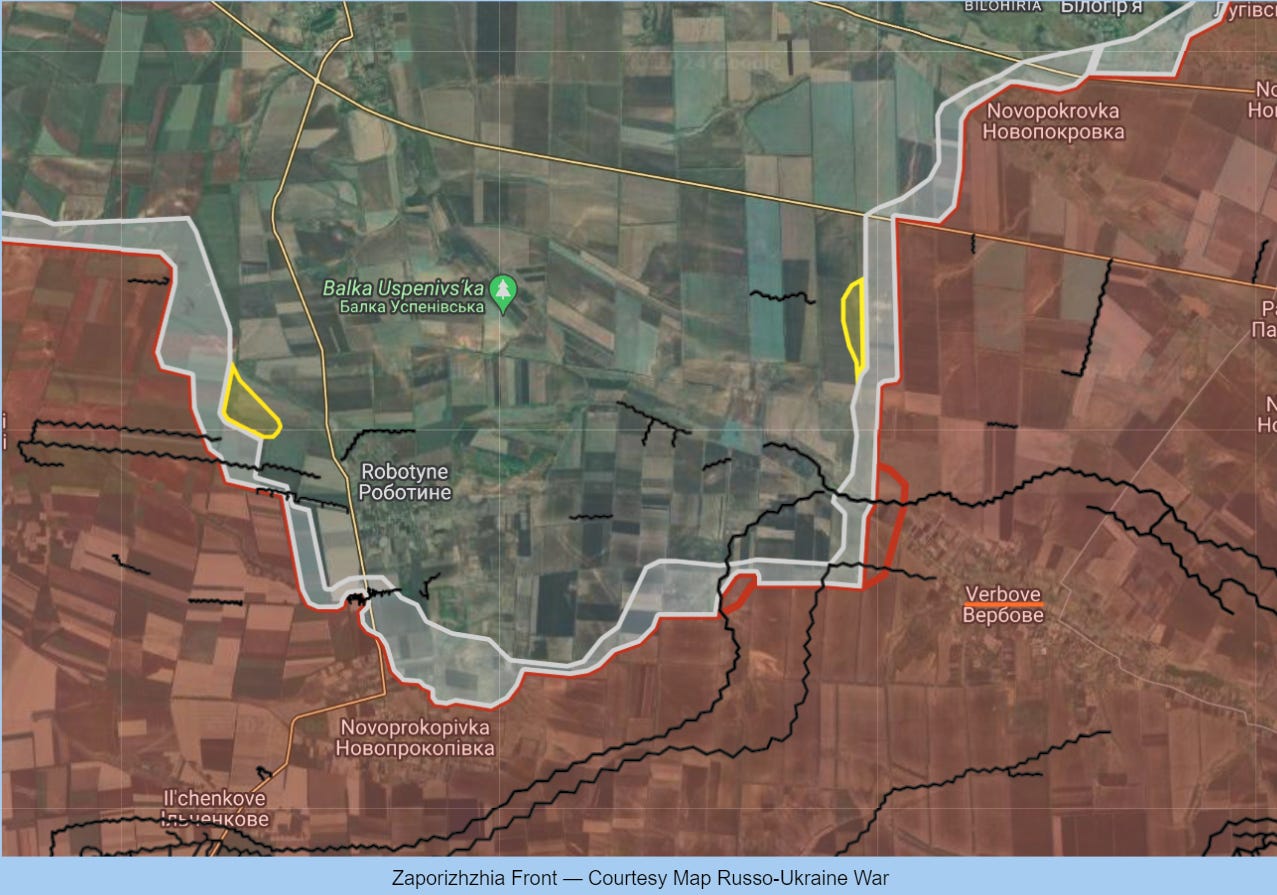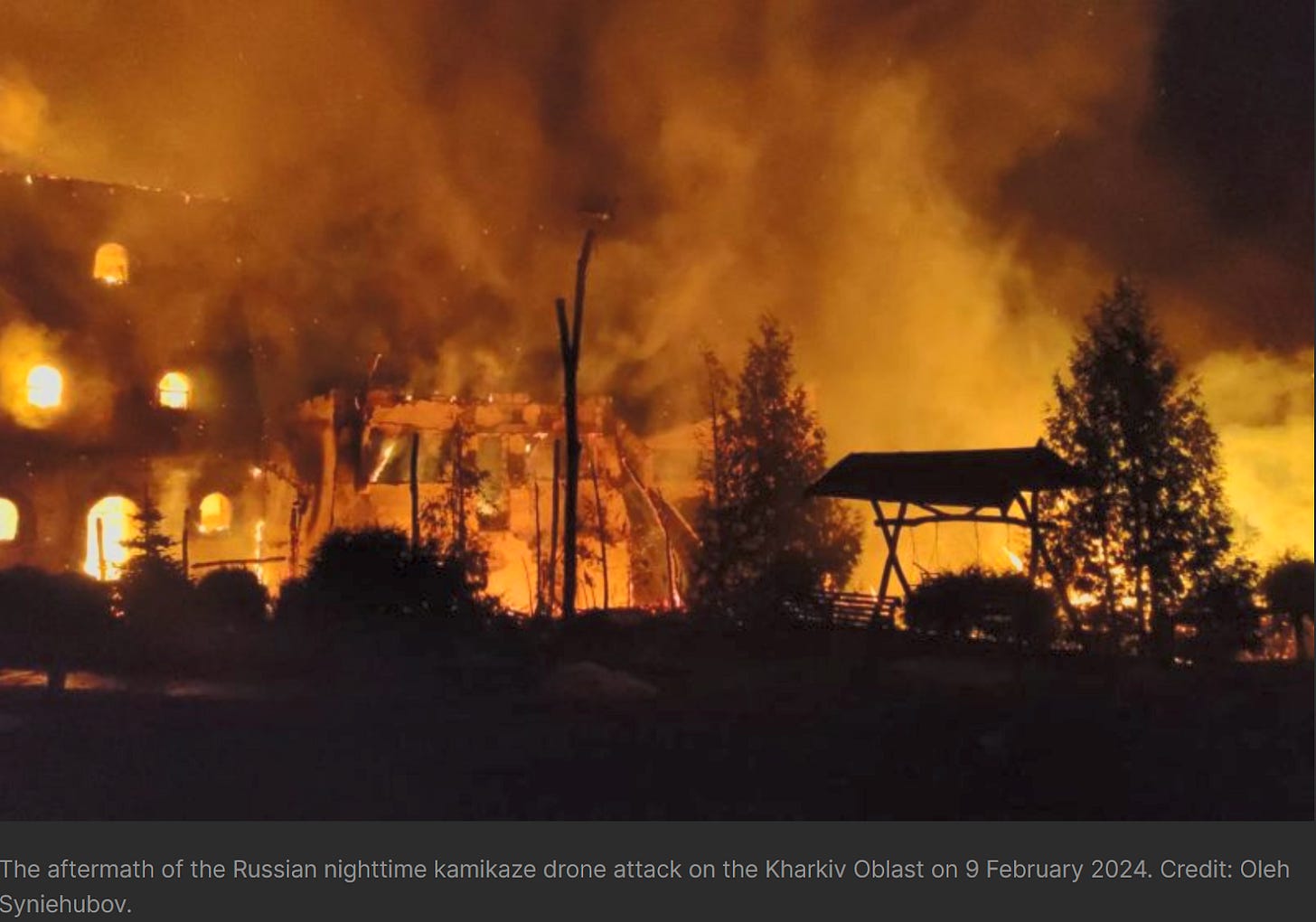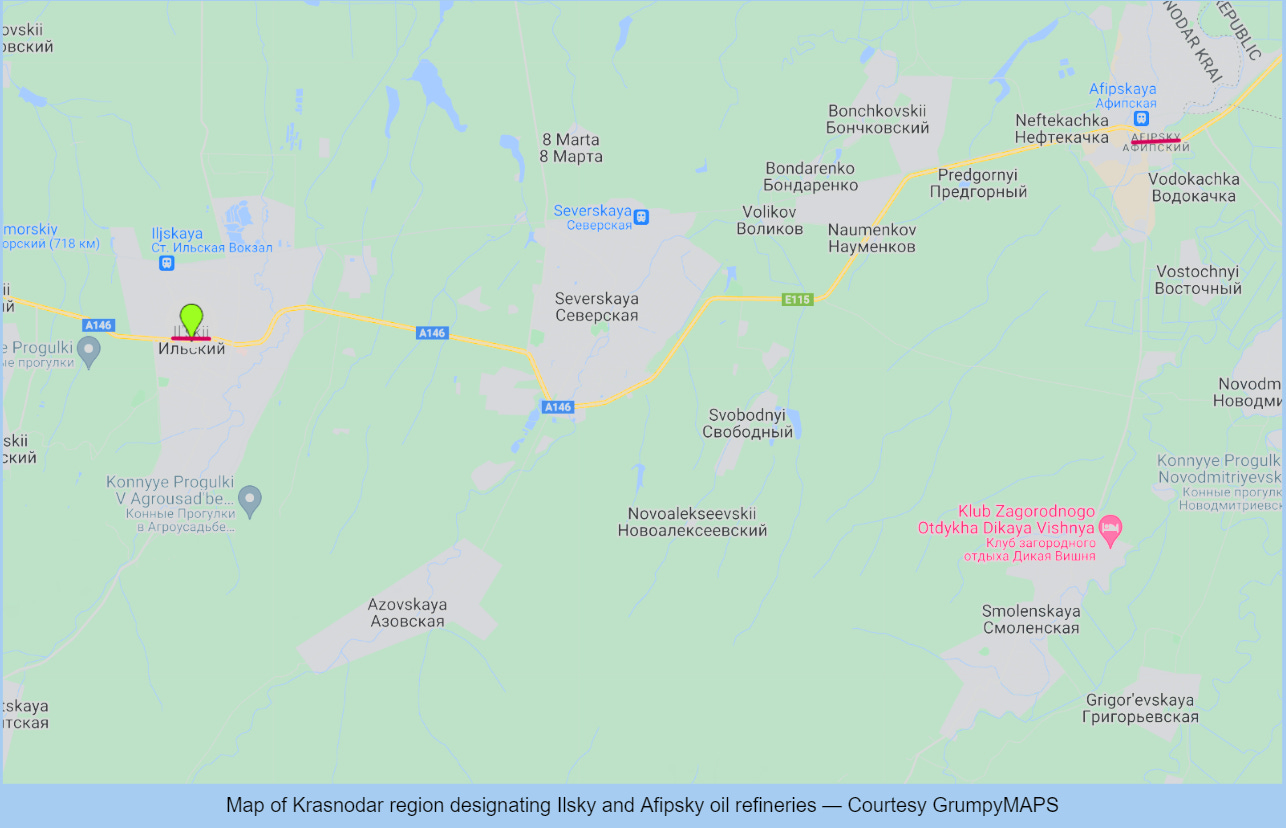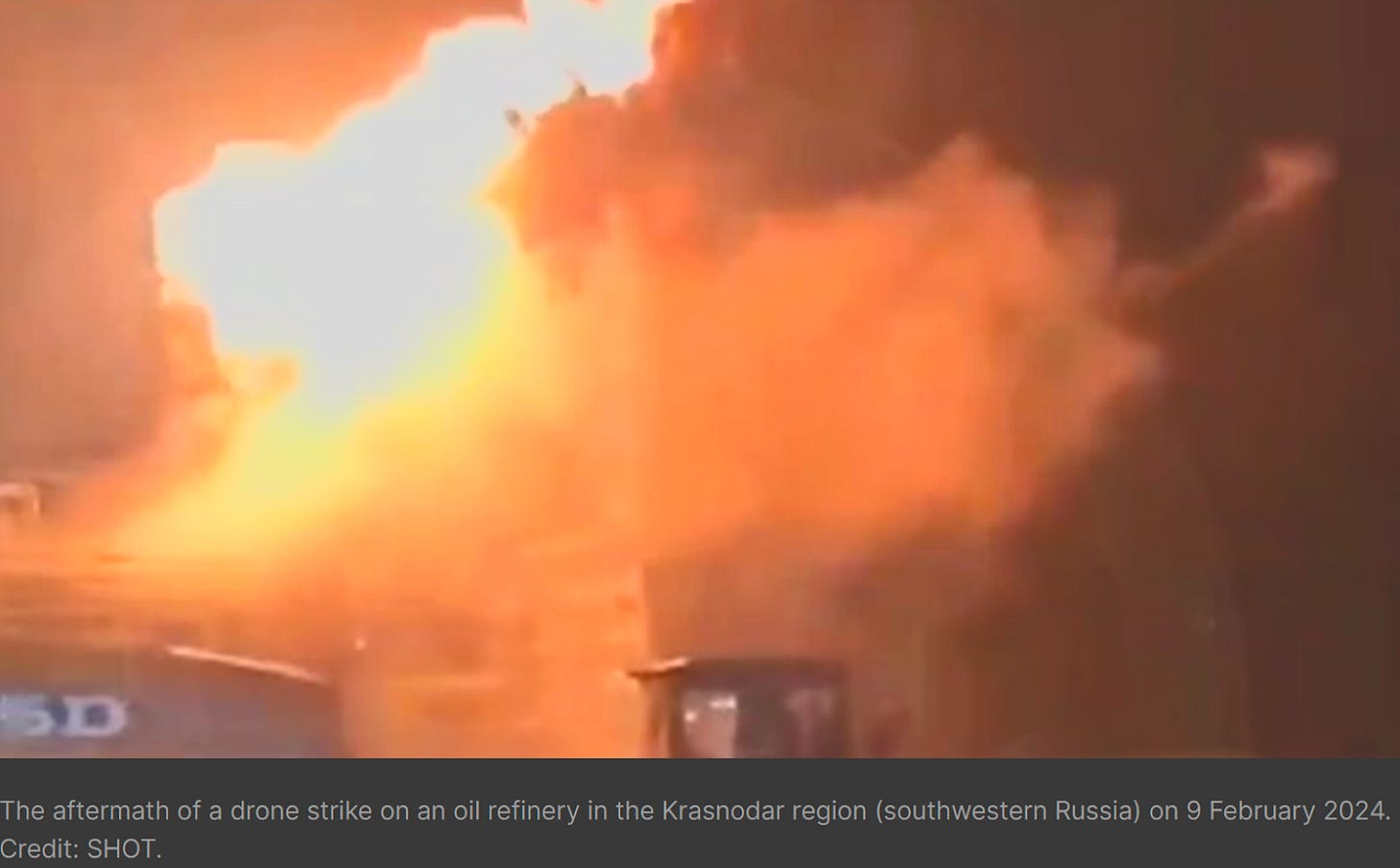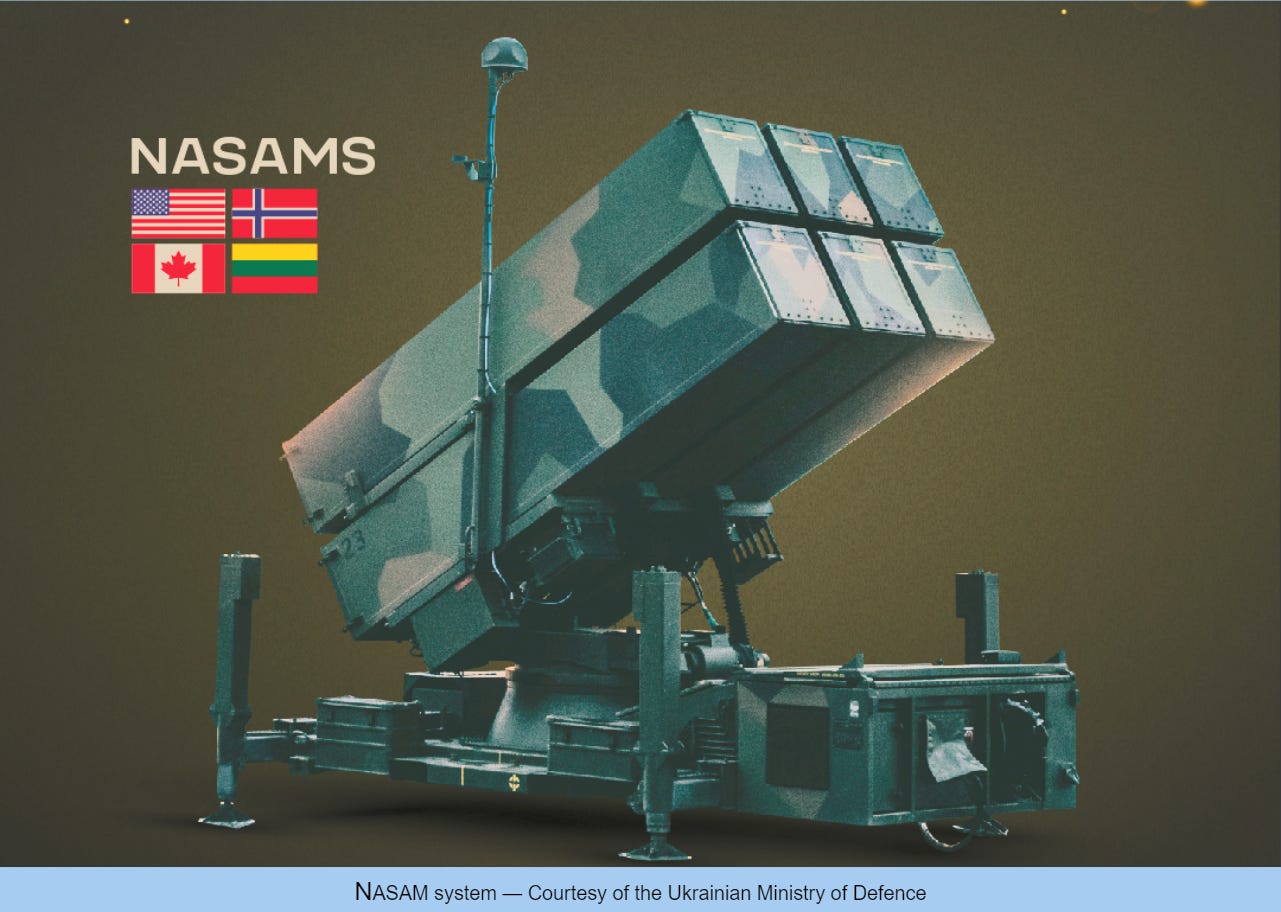Slava Ukraini! Since June 2023 I have provided a daily draft for the Ukraine War Brief Podcast collecting news from over 40 sources daily much of which ends up in the script. I will make this Draft available here for those who wish to keep up with events on a daily basis.
INSIDE UKRAINE
ALONG THE CONTACT LINE
GSAFU Morning Report
The General Staff of the Armed Forces of Ukraine in its situation update at 06:00 on Feb. 9 stated that it was day 716 of the full-scale invasion of the Russian Federation against Ukraine.
During the past day, 65 combat engagements took place. Over the past 24 hours, the enemy carried out 13 missile strikes, 66 air strikes, and 96 MLRS attacks across the positions of our troops and settlements. As a result of the Russian attacks, unfortunately, there are dead and wounded among the civilian population. Destruction and damage to residential buildings and other civilian infrastructure.
At the same time, Ukrainian soldiers continue to inflict losses in manpower and equipment on the occupying troops, exhausting the enemy along the entire front line.
The Khortytsia operational-strategic group is responsible for the Kup’yans’k, Lyman, and Bakhmut axes, in the northeastern part of Ukraine.
Kup’yans’k axis: Ukrainian defenders repelled 5 attacks of the enemy near the settlements Synkivka and Ivanivka (Kharkiv oblast)
Lyman axis: Ukrainian defenders repelled 4 attacks near Terny (Donetsk oblast)
Bakhmut axis: Ukrainian forces repelled 4 attacks near Ivanivske and Klishchiivka (Donetsk oblast)
The Tavria operational-strategic group is responsible for the Avdiivka, Mar’inka, Shaktars’ke, and Zaporizhzhia axes, in the central-eastern and southeastern part of Ukraine.
Avdiivka axis: Ukrainian defenders continue to hold back the enemy who keeps trying to encircle Avdiivka. AFU soldiers are standing their ground and inflicting major losses on the invaders. Ukrainian Defense Forces repelled 19 enemy attacks near Avdiivka, plus 7 near Pervomais’ke and Nevel’s’ke (Donetsk oblast).
Mar’inka axis: Ukrainian Defense Forces continue to hold back the occupiers in the vicinities of Heorhiivka, Pobeda and Novomykhailivka (Donetsk oblast). Troops repelled 16 attacks in that area.
Shakhtarske axis: The enemy did not conduct any offensive (assault) operations.
Zaporizhzhia axis: Ukrainian Defense Forces repelled 1 attack west of Verbove (Zaporizhzhia oblast).
The Odesa operational-strategic group is responsible for Kherson, Qırım, (also known as Crimea) and the Black Sea.
Kherson axis: Ukrainian defenders continue to expand the bridgehead. Despite significant losses, the enemy does not abandon its attempts to dislodge Ukrainian troops from their positions. Over the past day, the enemy carried 2 unsuccessful assaults on the positions of the Ukrainian Defense Forces.
TEMPORARILY OCCUPIED TERRITORIES
Nothing to report.
THE HOME FRONT
Another 100 Ukrainian POW’s exchanged
The GSAFU announced on Feb. 8 that another 100 Ukrainian POW’s had been exchanged - including National Guard, Border Guard and ZSU members. Most were defenders of Mariupol. All are back on home soil.
“Another 100 Ukrainians are back home in Ukraine. National Guard, Border Guards, and Armed Forces. The majority of them are Mariupol defenders.
These are all our people, and they have returned to their homeland. We are working on bringing back every Ukrainian who is still in captivity, and we will not stop until we do.
I am grateful to our team involved in the prisoner exchanges for the result the country needs.”
— Volodymyr Zelenskyy, President of Ukraine
Another massive drone attack on Ukraine
Russia unleashed a barrage of kamikaze drone attacks on Ukraine last night, targeting civilian infrastructure and causing injuries and damage in several regions.
Last night, Russia attacked several regions of Ukraine with Shahed, Lanset, and FPV kamikaze drones. According to the Ukrainian Air Force, the air defence took down 10 of 16 Shaheds.
Russia attacks Ukrainian cities with kamikaze drones almost every day, targeting military and critical civilian infrastructure and often causing casualties among civilians.
Last night, the Russian army launched Shahed-131/136 kamikaze drones from Cape Chauda in occupied Crimea (southern Ukraine) and Kursk region (western Russia), Ukraine’s Air Force reported.
In the Kharkiv Oblast (eastern Ukraine), Russian kamikaze drones attacked the civilian infrastructure of the Zmiiv community, injuring a security guard, the head of the Kharkiv Oblast State Administration, Oleh Syniehubov, reported.
During a Russian nighttime drone attack, Ukrainian defenders landed a Shahed kamikaze drone using electronic warfare systems in the Dnipropetrovsk Oblast (eastern Ukraine). According to the National Police of Ukraine, the drone crashed in a field away from residential areas.
Military psychologist Andrii Kozinchuk: We have lots of great specialists, but there is no system
The war has divided Ukrainian society into those who are fighting at the frontlines and those who are in the rear, those who have been forced to leave the country and those who remain under missile attacks in Ukraine, those who are still having fun and those who disapprove of it. But we all live in wartime.
Military psychologist Andrii Kozinchuk explained how Ukrainians find understanding, deal with soldiers, and overcome stress in an interview with RBC-Ukraine.
The work of a military psychologist is divided into three stages: before, during, and after the battle. "Before" is preparation, screening, what the guys do, who they are, where they come from, what their morale is like. We teach them about stress and its consequences, so they don't panic about their reactions. We conduct surveys to understand who we are dealing with, see how they interact and react to each other because they will later have to go through a psychologically traumatic event together.
Psychologists usually don't storm positions. "During," we work with those who have withdrawn - those who are scared, paralyzed, meaning acute reactions or complete absence of reaction. We observe how people react to loss, to injuries.
Then there is "after", also known as recovery, when everything is over and we пщ somewhere else. We conduct a group analysis of actions taken, which can be somewhat emotional sometimes. We ask soldiers what they saw, what they felt, and what they did. This way, the fighter trains his brain to analyse things without emotions.
There is growing misunderstanding in society between those who are at war and those who are not. How to overcome this division?
In all armed conflicts, there's a period after returning from the war: euphoria, disappointment, aggression, depression, acceptance. Nobody stops at euphoria. Maybe someone will stop at disappointment and keep shouting "betrayal," someone at aggression – storming liquor stores. If the goal of the vacation is to restore strength, not to relax, then after the war, you need to integrate into society.
Because there's an idea that society must understand us. No. Here's society, and here are the military – our task is to meet halfway. Shake hands and say we love each other, let's live together. But it's a long process – and there will be different people, a surge in suicides, disappointments, some will turn to faith, others will become atheists, families will fall apart and reunite. I would really like the state to have a policy and a system of what to do next. Because we have a lot of cool specialists – psychologists, psychiatrists, sociologists, priests – but there's no system.
– Should the state create such a system?
Not necessarily. I like the system in Denmark – there are many who fought in Iraq. When they returned, the state recognized that it couldn't cope. Then civil organisations joined, the state partly finances them, controls them, helps them, promotes them.
Americans have calculated that investments in veterans' mental health pay off almost 10 times. If a veteran has normal mental health, he goes to work. The task of Americans is to make sure he goes to work and spends his earnings. And they said: let's love the veteran, make movies about him.
– There's an opinion that Ukrainians are historically warriors, so it reveals itself in war.
Genetic memory is a "memory card" from previous generations. This gene activates when it's needed. A person, entering a state of severe distress, acquiring new skills, finds it within themselves. Right now, in the army, there are intellectuals, intellectuals, the working class, the clergy. This is not everyone's story, but relatively many. As a psychologist, I relate this not historically to the Cossacks, but biologically. According to the genetic code, there's this thing that we're descendants of Cossacks, Varangians. Especially among those who went to war, there are two stages: during the war "I want to go home" and at home "I'd rather be at war already", there's no third.
– Many families fall apart because of war. How serious is this problem now? Which marriages are worth saving, and which are not?
It's not a problem. The problem is when you're in a marriage, but it's toxic, the husband beats, the wife cheats, but you're a family because what will people say – that's a disaster. And what is a good divorce – when a couple splits and both become happy. Relationships are when a partner gives resources and energy. For us, it's important not to preserve the family but to preserve the individuality because we have a lot of domestic violence, stalking (when a husband asks where you are, controls presence).
There's currently a wave of divorces because there was a wave of marriages in the first three months of the war, "I fell in love with him on the front line." You can't form a couple in traumatic events. There's a 94% likelihood it will break up in safety. If a person is in danger and can't escape, they look for someone to unite with. The easiest way to do this is by getting married.
THE RUSSIAN WORLD
Ukraine disrupts Russian fuel supply with strikes on oil refineries
Last night, powerful explosions caused a fire at several oil refineries in Russia, Russian media reported.
Ukraine, using long-range kamikaze drones, attacked Russian oil refineries that provide fuel for the Russian army to support its invasion of Ukraine.
Ukraine’s Security Service (SBU) launched kamikaze drones to attack oil facilities in two Russian regions last night, the Ukrainska Pravda reported, citing unnamed sources in the SBU. The drones hit Ilsky and Afipsky oil refineries in the Krasnodar region (southwestern Russia) sparking a massive fire and destroying a key processing unit.
According to the Ukrainska Pravda, the attack on the Ilsky oil refinery caused a severe fire. As a result of the drone strike, a primary processing unit with a capacity of 3.6 million tons per year was damaged. The price of such a unit is around $50 million.
Another drone at the same time fell into the territory of the oil depot in the village of Stal'noy kon' of the Orlovsk region. After the fall, the drone exploded however no damage or casualties could be confirmed at this location.
UK Intel – Catastrophic accidents at Russian Defence plants likely to continue
The UK Ministry of Defence in its Feb. 9 Intelligence Update noted that on Feb. 7 there were reports of an explosion at a Russian missile factory near Izhevsk in central Russia, which is used to produce a range of ballistic missiles, including the Iskander, which have been frequently deployed against Ukraine.
Initial reports suggested the explosion was due to worker error, although later the Russian state TASS news agency reported it was due to 'planned tests' of rocket engines.
It is unlikely, UK Defence Intelligence stressed, that Ukrainian drones were involved in the incident, given the distance of 1,200 kilometres from Ukrainian territory. Moreover, they added that there have been no reports of similar attacks in the area.
"This is at least the fifth unexplained military industrial factory explosion in four months. Previous explosions include the Kamensky chemical plant in Rostov on 15 January 2024; the Chelyabinsk tank factory on 26 November 2023 and gunpowder and ammunition factories in Kotovsk on 10 November 2023 and Solikamsk on 31 October 2023,"
The MOD concludes that there is a realistic possibility that the explosion was due to negligent handling and storing of highly volatile, combustible and explosive materials. Additionally senior political pressure to increase military industrial output targets to support the war in Ukraine has likely led to round the clock production and staff fatigue. Increased demands on production will highly likely result in greater numbers of industrial accidents going forwards.
NEWS WORLDWIDE
US Senate advances $95 bln Ukraine, Israel aid bill after failed border deal
WASHINGTON, Feb 8 - Reuters reports that a $95.34 billion bill that includes aid for Ukraine, Israel and Taiwan advanced in the U.S. Senate on Thursday after Republicans blocked a bi-partisan negotiated bill that included a long-sought overhaul of immigration policy the previous day
Senators backed a procedural motion by 67-32, exceeding the 60-vote threshold to advance the bill. Seventeen Republicans voted in favour, in a surprising shift after they blocked the broader bill on Wednesday.
"This is a good first step. This bill is essential for our national security, for the security of our friends in Ukraine, in Israel, for humanitarian aid for innocent civilians in Gaza, and for Taiwan," Schumer said in the Senate after the vote.
The security aid bill includes $61 billion for Ukraine as it battles a Russian invasion, $14 billion for Israel in its war against Hamas and $4.83 billion to support partners in the Indo-Pacific, including Taiwan, and deter aggression by China.
The Senate is expected to take days to agree on a final version of the security aid package, with some Republicans continuing to push for amendments. Supporters of Ukraine have been struggling for much of the past year to find a way to send more money to help Ukrainian President Volodymyr Zelenskyy's government.
Democratic Senator Chris Murphy, one of the three negotiators on the border deal, told Reuters the biggest potential risk to the Ukraine bill would be opposition by Trump.
Trump, who leads in the race for the Republican presidential nomination, has called for de-escalation in Ukraine and said he would have the conflict resolved in 24 hours if he were reelected. He also has said he would ask Europe to reimburse the U.S. for money sent to Ukraine.
German chancellor discusses support for Ukraine with US senators
Olaf Scholz, the Chancellor of Germany, said that he held a meeting with senators during his visit to the United States.
Scholz said that Ukraine needs all kinds of support to defend itself against Russian aggression. "It was good to talk again with members of the US Senate from both sides of the aisle," he noted.
Norway plans to send Ukraine more NASAMS air defence systems
The Norwegian government has proposed to the parliament that more launchers and fire control centres for NASAMS air defence systems should be ordered from the manufacturer to be sent to Ukraine.
"The Government proposes to the Norwegian Parliament to order a further ten launch units and four fire control centres of the air defence system NASAMS from Kongsberg Defence and Aerospace (KDA). This is done in addition to repurchasing the equipment that has already been donated to Ukraine."
— Norwegian Government official statement
The amount of equipment that may be delivered to Ukraine from the new order was not specified.
“Norwegian NASAMs system saves Ukrainian lives and prevents the destruction of buildings and infrastructure. The Russian missile and drone attacks are extensive and brutal, so air defence is absolutely decisive for Ukraine," Norway’s Defence Minister Bjørn Arild Gram noted.
MILITARY & TECH
Rare Footage of British AIM-132 ASRAAM Launcher Deployed in Ukraine Emerges
A video has appeared online featuring one of the British AIM-132 ASRAAM launchers deployed in Ukraine. Defense Express reports.
The system was only ever seen once before in a video released by the Air Force Command of the Armed Forces of Ukraine in October 2023, during nighttime operations against the Shahed kamikaze drones used by the russian occupation forces.
Back in August 2023, Western media reported that the United Kingdom reinforced Ukraine's air defense with guided AIM-132 ASRAAM air-to-air missiles.
The main tactical and technical characteristics of the AIM-132 ASRAAM missile are as follows:
Weight: 88 kg
Warhead (fragmentation-explosive): 10 kg
Diameter: 166 mm
Length: 2900 mm
Launch range: 25 km
Maximum flight speed: 3 mach.
However, in the ground-launched variant, the AIM-132 ASRAAM missile will likely have a shorter range, possibly up to 10 km. Therefore, these systems can effectively replace the Soviet-era SAM systems like the Osa in the Armed Forces of Ukraine.
It is also worth noting that the missile is equipped with an infrared homing head, allowing this British SAM system to operate in a "silent" mode without activating the radar station. The AIM-132 ASRAAM missile is an air-to-air missile, but it can be used as an anti-aircraft missile due to the sufficiently high energy of the engines.
Ukraine develops new tactical kamikaze drones
Militarnyi reports citing Ukraine’s Deputy Prime Minister and Minister for Digital Transformation, Mykhailo Fedorov, stating that a development program for a new combat tactical drone capable of striking targets up to 40 kilometres away has been ongoing for months. Several different models are already being tested.
This will double the range of tactical drones available to Ukrainian soldiers at the front. It is expected that the new drone will incorporate features from the very successful Russian Lancet Drone. That is, the double cross of X wing configuration that provide extra lift and also allows for the reduction of dimensions.
That’s it for today’s Draft folks if you would like to keep up with events in Ukraine daily please consider subscribing, its free!
Feel free to share this update with your friends. Heroyam Slava!







